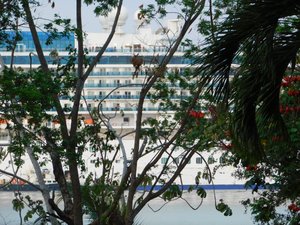Advertisement
Published: March 27th 2019

 Cruise Ship
Cruise Ship
with Mike's camera, you can see the decks!Day 2--first full day here--After watching a cruise ship, the Coral Princess, float by, started with breakfast at the hotel and an orientation meeting where we met our guides, updated the schedule, and learned the ground rules. Basically, no one in Panama pays attention to time but we are to be on time for the buses.
This morning we went to Panama la Vieja, the original part of panama city, the section destroyed by Morgan when he sacked the city (more later). First, a trip through the Panama , Canal Museum, then a short time to wander, then a walking tour of the old city and some plazas, ending at the French Plaza and a bus trip to lunch. We were divided into 3 groups today because the old city cannot accomodate a big bus.
Notes from the guide's narration on the bus:
• the high rises in Panama City have been built beginning in 2008;
• early morning, ships go North through the Canal (as the cruise ship we saw this morning), afternoon South, smaller ships can go at night;
• since 1963, the Canal has been operating 24/7;
• The Panamanian flag: the red block is for the liberal

 Light House
Light House
designed by Eiffelparty the blue is for the conservative party, the white ones for peace.
• There has not been an Army in Panama since the overthrow of Noriega by the Americans in (so-called) Operation Just Cause;
• there are, however, 18000 police in Panama; and
• the majority of the population is between 15 and 45 years of age.
Our group went first to the museum.of the Canal.Our guide, Juan Carlos (JC), was entertaining, knowledgeable, friendly, a great guy. As you enter, there's 'the lighthouse', the top part which throws off the light. Designed by Eiffel during the French effort to salvage their operations. Going on time, the first exhibit is of the movement of the continents and the formation of Panama, one of the last pieces of land to rise out of the water. Lots of information on how that divided the Atlantic and Pacific and eventually formed the Gulf Stream, allowing Britain to thaw and support people. Then we saw Balboa who finally believed the indigenous people when they said there was another big body of water over the mountains, let them lead him there, and became the first European to see the Pacific from Panama. Then came Henry Morgan,
pirate if you were Spanish, privateer if you were English, who raided Panama City. Happily, we had read The Path Between the Seas and so the names of the French who tried first to build the Canal and the mess they created for themselves and Panama were familiar, as were the steps Teddy Roosevelt took to 'liberate' Panama.
During our little break, Mike and I went to see the Altar d'Oro which somehow was missed by Morgan when he sacked the city. We found our way back to Liberation Square, in front of the hotel where liberty was declared.
Then began a walking tour of the old city to several plazas and views of the Pacific. Since the old city has been named a UNESCO World Heritage site, the people who owned the buildings have recognized their value and reclaimed them. For years, squatters were living in the buildings and now they have new value and are part of the gentrification of the old city. At one plaza, a woman from the San Blas Islands was selling moles, the beautiful layered quilted and embroidered fabrics that are a Panamanian original textile.
Then we walked on to the
French Plaza, home of the French Embassy and several signs of friendship between the two nations. Up the stairs and onto an overlook with views of the bridge, the Pacific (at low tide--it has 15-22' tides), and the skyline of Panama City. On to the bus (we were quite grateful for the AC and water!) and off to lunch.
As the Canal was being built, all the rock and dirt had to go somewhere. The Amador Causeway was formed with some of it. Our hotel is on it, just below the Bridge of the Americas, and it extends about 4 miles into the Pacific with three small 'islands' on the way. Last night, walking, we had made it to the Biomuseo and the beginning of the causeway to the islands. Today, for lunch, we went to the furthest one, Flamenco. When ships come to the Canal to enter at the Pacific, the first contact they make with the Canal is the Flamenco station.
Lovely lunch featuring seafood and more wonderful fresh fruit. Sat with a nice couple from the San Francisco Bay area.
The bus dropped us off at the Biomuseo which we toured--all about the evolution
of the isthmus and the animals, plants, and peoples living here. Beautiful open spaces and lots of color. Enjoyed a bottle of tea (and Mike another great espresso, this one a double) on the veranda watcing the Canal. the walk back to the hotel, 1.4 miles along the Canal, was hot and tiring. A dip in the pool helped that!
Great historic lecture at 5, with several slides explaining the working of the Canal and showing the new construction, which really helped me better understand it. Dinner poolside where we chatted further with some more members of the group.
Exhausting day!!
Advertisement
Tot: 0.081s; Tpl: 0.017s; cc: 12; qc: 28; dbt: 0.0425s; 1; m:domysql w:travelblog (10.17.0.13); sld: 1;
; mem: 1.1mb























